TO
Filters: Collection: "ir_eua"
| Title | Date | Subject | Description | ||
|---|---|---|---|---|---|
| 1901 |
 |
Project management plan: Clean and secure energy from domestic oil shale and oil sands resources | 2009-11-03 | domestic oil shale; oil sands; energy in domestic oil shale and oil sands; efficient CO2 capture; liquid fuel production; in-situ thermal processing. | The University of Utah (the Recipient), via their Institute for Clean and Secure Energy (the Institute), shall pursue research to improve industry's ability to utilize the vast energy stored in domestic oil shale and oil sands resources in a manner that shall minimize environmental impact and effect... |
| 1902 |
 |
Project Management Plan: Revision B - Clean and Secure Energy from Coal June 30, 2011 | 2011-06-30 | CO2 capture; stationary power generation; PMP; clean coal utilization; oxy-coal combustion; entrained-flow coal gasification; coal gasification; SNG; chemical looping combustion | The University of Utah (the Recipient), via their Institute for Clean and Secure Energy (ICSE), shall pursue research to utilize the vast energy stored in our domestic coal resources and do so in a manner that will capture CO2 from combustion for stationary power generation. The research is organize... |
| 1903 |
 |
Project Management Plan: Revision C - Clean and Secure Energy from Coal November 22, 2011 | 2011-11-22 | PMP; clean coal utilization; power generation; oxy-coal combustion; entrained-flow coal gasification; chemical looping combustion | The University of Utah (the Recipient), via their Institute for Clean and Secure Energy (ICSE), shall pursue research to utilize the vast energy stored in our domestic coal resources and do so in a manner that will capture CO2 from combustion for stationary power generation. The research is organize... |
| 1904 |
 |
Project Management Plan: Revision D - Clean and Secure Energy from Coal April 6, 2012 | 2012-04-06 | PMP; domestic coal resources; CO2 capture; stationary power generation; clean coal utilization; power generation; oxy-coal combustion; coal gasification | The University of Utah (the Recipient), via their Institute for Clean and Secure Energy (ICSE), shall pursue research to utilize the vast energy stored in our domestic coal resources and do so in a manner that will capture CO2 from combustion for stationary power generation. The research is organize... |
| 1905 |
 |
Project transition from technology development to operational deployment | 2011-05-17 | unconventional fuel; oil reserves; bitumen; oil sands | This presentation and the Company's website referenced in this presentation contain forward-looking statements including expectations of future production and components of cash flow and earnings. Investors are cautioned that assumptions used in the preparation of such information may prove to be in... |
| 1906 |
 |
Projections for school population and teacher demand in the State of Utah for the period 1970-2000 | 1975 | This study deals with probable future trends in student enrollment, accoroing to age, sex, grades, and school levels, for different geographic areas, and teacher demand for the elementary and secondary levels of school in Utah from 1970 to the year 2000. For the secondary level schools, information ... | |
| 1907 |
 |
Properties of GPC separated maltene fractions derived from Utah and Athabasca bitumen | 1989-11-17 | GPC; maltene fractions; Utah bitumen; Athabasca bitumen; oil sands; Gel Permeation Chromatography | This work deals with bitumens derived from two different types of oil sands: 1) Athabasca from the HcHurray formation in Alberta, Canada and 2) from the Unita basin in the green River formation, Utah, USA. Maltenes separated from these two bitumen were fractionated by Gel Permeation Chromatography (... |
| 1908 |
 |
Properties of Utah tar sands--Asphalt Wash area, P. R. Spring deposit | 1975 | Asphalt Wash Area; P. R. Spring tar sand deposit; tar sand zones; oil; tar sand evaluation | This Bureau of Mines report presents the analysis of three cores from the Asphalt Wash area of the P.R. Spring tar sand deposit of northeastern Utah. Two tar sand zones are indicated in the Asphalt Wash Area. Total net thickness of the tar sand ranges from 23 to 39 ft, with occurrences between 56 an... |
| 1909 |
 |
Properties of Utah tar sands--Flat Rock Mesa area, Hill Creek deposit | 1976-04-01 | Flat Rock Mesa Area; Hill Creek tar sand deposit; tar sand zone | This report presents the results of analyses of three cores from the Flat Rock Mesa area in the Hill Creek tar sand deposit in northeastern Utah. Two major tar sand zones exist in the Flat Rock Mesa area and have net thicknesses ranging from 55 to 81 ft. The overall tar sand section has good porosit... |
| 1910 |
 |
Properties of Utah tar sands--North Seep Ridge area, P. R. Spring deposit | 1980-02-13 | P. R. Spring tar sand deposit; Seep Ridge area; tar sand zones | This report presents results of analyses made at the Laramie Energy Research Center of three cores from an area at the northern end of Seep Ridge in the P.R. Spring tar sand deposit in northeastern Utah. Up to five tar sand zones have been identified in the north Seep Ridge area. These zones occur b... |
| 1911 |
 |
Properties of Utah tar sands--South Seep Ridge area, P. R. Spring deposit | 1975 | Seep Ridge area; P. R. Spring tar sand deposit; tar sand zones | The Bureau of Mines analyzed three cores from the south Seep Ridge area of the P. R. Spring tar sand deposit of northeastern Utah. Four tar sand zones are indicated in the area. The zones range in average thickness from 13 to 24 ft. The total net thickness of the tar sand in the three coreholes rang... |
| 1912 |
 |
Properties of Utah tar sands--Three Mile Canyon area, P. R. Spring deposit | 1974 | Threemile Canyon area; P. R. Spring tar sand deposit; oil zone; oil extraction; tar sands | Results of detailed analyses of four cores from the Threemile Canyon area in the P. R. Spring tar sand deposit in Utah are reported by the Bureau of Mines. The cores were obtained by the Utah Geological and Mineralogical Survey as part of a 17-corehole evaluation program in the P. R. Spring, Hill Cr... |
| 1913 |
 |
Proportional aggregation program for SAM projection files | From two to ten inout files may be aggnegated in any run. All files must span the same projection peneod, and must also contain the same subareas. | ||
| 1914 |
 |
Proposal for historian position (UUSAC) | Historian position | A written proposal for adding an historian position to the Staff Advisory Committee. This outline includes a descrition of some of the duties and the process for appointment. | |
| 1915 |
 |
Proposal for the development, calibration, and application of an empiric activity allocation model for the Wasatch Front urban area of Utah | 1968-07 | The comprehensive land development and transportation planning process for a growing region like the Wasatch Front should tie together all the interrelated planning activities -- establishing land development and transportation policies, forecasting land development and activities, forecasting trave... | |
| 1916 |
 |
Proposed natural gas protection program for naval oil shale reserves nos. 1 and 3, Garfield County, Colorado | 1991-08 | naval oil shale reserves; environmental assessment; naval petroleum reserves; oil shale | Environmental Assessment analysis completed for Naval Oil Shale Reserves Nos. 1 and 3 (NOSRs-1 & 3), located in Garfield County, Colorado. |
| 1917 |
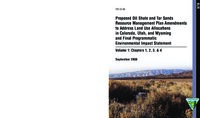 |
Proposed oil shale and tar sands resource management plan amendments to address land use allocations in Colorado, Utah, and Wyoming and final programmatic environmental impact statement: Volume 1: Chapters 1, 2, 3, and 4 | 2008-09 | oil shale; tar sands; resource management; domestic energy resources. | In August 2005, the U.S. Congress enacted the Energy Policy Act of 2005, Public Law (P.L.) 109-58. In Section 369 of this Act, titled the "Oil Shale, Tar Sands, and Other Strategic Unconventional Fuels Act of 2005", Congress declared that oil shale and tar sands (and other unconventional fuels) are ... |
| 1918 |
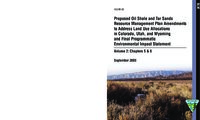 |
Proposed oil shale and tar sands resource management plan amendments to address land use allocations in Colorado, Utah, and Wyoming and final programmatic environmental impact statement: Volume 2: Chapters 5 and 6 | 2008-09 | oil shale; tar sand; resource management; resource management amendments; domestic energy resource. | In August 2005, the U.S. Congress enacted the Energy Policy Act of 2005, Public Law (P.L.) 109-58. In Section 369 of this Act, titled the "Oil Shale, Tar Sands, and Other Strategic Unconventional Fuels Act of 2005", Congress declared that oil shale and tar sands (and other unconventional fuels) are ... |
| 1919 |
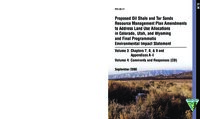 |
Proposed oil shale and tar sands resource management plan amendments to address land use allocations in Colorado, Utah, and Wyoming and final programmatic environmental impact statement: Volume 3: Chapters 7, 8, and 9 and appendices A-1: Volume 4: Comments and responses (CD) | 2008-09 | oil shale; tar sands; resource management plan; developing energy resources; domestic energy resources. | In August 2005, the U.S. Congress enacted the Energy Policy Act of 2005, Public Law (P.L.) 109-58. In Section 369 of this Act, titled the "Oil Shale, Tar Sands, and Other Strategic Unconventional Fuels Act of 2005", Congress declared that oil shale and tar sands (and other unconventional fuels) are ... |
| 1920 |
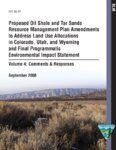 |
Proposed oil shale and tar sands resource management plan amendments to address land use allocations in Colorado, Utah, and Wyoming and final programmatic environmental impact statement: Volume 4: Comments and responses | 2008-11 | oil shale; tar sand; resource management plan; domestic energy resources. | In August 2005, the U.S. Congress enacted the Energy Policy Act of 2005, Public Law (P.L.) 109-58. In Section 369 of this Act, titled the "Oil Shale, Tar Sands, and Other Strategic Unconventional Fuels Act of 2005", Congress declared that oil shale and tar sands (and other unconventional fuels) are ... |
| 1921 |
 |
Propulsion and power rapid response research and development (R&D) support - Delivery order 0011: Advanced propulsion fuels research and development -- Subtask: Framework and guidance for estimating greenhouse gas footprints of aviation fuels | 2009-04 | propulsion research and development; power rapid response research and development; R and D; greenhouse gas emissions; petroleum based fuels; alternative fuels; propulsion fuels | Although there have been extensive analyses of the greenhouse gas emissions associated with petroleum based fuels and alternative fuels, there are still substantial uncertainties associated with some of the estimates of the greenhouse gas impacts of these fuel systems. Nevertheless, a variety of gov... |
| 1922 |
 |
Protecting sage grouse and their habitat in the west | 2012-05-15 | sage grouse; endangered species act | |
| 1923 |
 |
Prudhoe Bay--a 10 year perspective | 1980 | Prudhoe Bay field; U. S. oil field; geology summary; reservoir potential; petroleum exploration | The Prudhoe Bay field is recognized as the largest oil field in the United States. The Permian-Triassic reservoirs, estimated to contain reserves of 9.6 billion bbl of oil and 26 Tcf of gas, have overshadowed other known substantial accumulations of hydrocarbons in formations ranging in age from Mis... |
| 1924 |
 |
PTO accrual tables - for HR use only (UUSAC) | 2012-03-21 | Exempt staff; Non-exempt staff; Paid leave; University of Utah staff | PTO bucket holds vacation, sick, holiday, and personal preference. Employees at .75 - .99 FTE will accrue at a pro-rated amount (.75 FTE will receive 15, 17.5, and 20 hours per month according to service years). Employees at .50 to .74 FTE will accrue a flat amount of 6 days per year, or four hour... |
| 1925 |
 |
Publications requirements | 2010 | ||
| 1926 |
 |
Pyrolysis kinetics for western and eastern oil shale | 1982-05 | oil shale; in-situ processing; fluidized-bed retorting; pyrolysis reactions; oil yeilds; organic pyrolysis reactions | Oil yield and kinetic results are reviewed for Western (Colorado Mahogany zone) and Eastern (Sunbury and Ohio (Cleveland member)) oil shales for conditions ranging from those encountered in in-situ processing to those in fluidized-bed retorting. We briefly summarize kinetic models for the pyrolysis ... |
| 1927 |
 |
Pyrolysis of Asphalt Ridge tar sand | 1986-08 | isothermal pyrolysis; nonisothermal pyrolysis; Asphalt Ridge tar sand; tar sand; oil production | Isothermal and nonisothermal pyrolysis experiments have been inducted on Asphalt Ridge tar sand. Oil produced from the isothermal xperiments has a molecular weight of approximately 250 and has a ydrogen to carbon ratio between 1.7 and 1.9. Product oil composition jries slightly with reaction time. R... |
| 1928 |
 |
Pyrolysis of bitumen impregnated sandstones: A comparison of fluidized-bed and rotary-kiln reactors | 1991-04 | bitumen pyrolysis; bitumen impregnated sandstones; fluidized-bed reactor; rotary-kiln reactors; reactor comparison; hydrocarbon recovery; processing strategies | The recovery of hydrocarbon values from the bitumen impregnated sandstones of Utah can be accomplished by any of several mining-surface recovery techniques. These processing strategies include aqueous separation, diluentassisted aqueous separation and solvent extraction of the bitumen from the sand ... |
| 1929 |
 |
Pyrolysis of oil shale from the Whiterocks tar sand deposit in a rotary kiln | 1992-04 | oil shale pyrolysis; Whiterocks tar sand deposit; rotary kiln; hydrocarbon value recovery; oil sands | The recovery of hydrocarbon values from the oil sands of Utah can be accomplished by any of several mining-surface recovery techniques. These processing strategies include aqueous separation, diluent-assisted aqueous separation and solvent extraction of the bitumen from the sand, and pyrolysis of th... |
| 1930 |
 |
Pyrolysis of Sunnyside (Utah) Tar Sand: Characterization of volatile compound evolution | 1988 | tar sand; pyrolysis | Sunnyside (Utah) tar sand was subjected to programmed temperature pyrolysis and the volatile products were detected by tandem on-line mass spectrometry (MS/MS) in real time analyses. A heating rate of 4°C/min from room temperature to 900°C was employed. Evolution of hydrogen, light hydrocarbons, n... |
| 1931 |
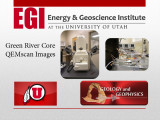 |
QEMSCAN analysis of Green River Formation oil shale samples, Skyline 16 core, eastern Uinta basin, UT | 2014 | QEMSCAN; oil shale; Green River Formation; Skyline 16 core; minerology | Conclusions in the presentations: 1. QEMscan analysis reveals mineralogic textures dominated by dolomite, illite, and calcite. 2. A few interpretations are made in regards to the documented compositional results generated automatically by the QEMscan: "Background" is assumed to reflect organic matt... |
| 1932 |
 |
Qget quality growth efficiency tools | 1997-12 | In the last six years Utah has experienced an unprecedented economic boom. Economic growth has attracted large numbers of residents from other states to Utah. High in-migration, combined with a consistently growing resident population, has applied pressure on Utah's existing transportation, water, ... | |
| 1933 |
 |
Qget quality growth efficiency tools | 1998-06 | In the last six years Utah has experienced an unprecedented economic boom. Economic growth has attracted large numbers of residents from other states to Utah. High in-migration, combined with a consistently growing resident population, has applied pressure on Utah's existing transportation, water, ... | |
| 1934 |
 |
QGET quality growth efficiency tools scenario analysis | 1999-03 | The Greater Wasatch Area is currently home to 1.6 million people (a population slightly smaller than the Portland metro area). By 2020, the population is expected to increase to 2.7 million people (a population roughly equivalent in size to the current population of the San Diego metro area). Th... | |
| 1935 |
 |
QGET: quality growth efficiency tools databook | 1997-07 | In the last six years Utah has experienced an unprecedented economic boom. Economic growth has attracted large numbers of residents from other states to Utah. High in-migration, combined with a consistently growing resident population, has applied pressure on Utah's existing transportation, educat... | |
| 1936 |
 |
Quality growth efficiency tools: progress report | 1997-04 | The Quality Growth Efficiency Tools project team has been meeting since July 1996 to develop a process and set of tools to improve the quality of growth related information to plan for Utah's future. The Project's stated purpose is to improve the technical and analytical models used to forecast gr... | |
| 1937 |
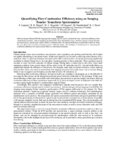 |
Quantifying flare combustion efficiency using an imaging fourier transform spectrometer | 2022 | Mid-wavelength infrared (MWIR) hyperspectral imaging may be used to calculate the flare combustion efficiency from standoff measurements, without requiring any information about the fuel flow rate to the flare. Species column densities are found using a spectroscopic model, which is combined with a ... | |
| 1938 |
 |
Quantitative methods for reservoir characterization and improved recovery application to heavy oil sands | 2001-11 | interwell reservoir heterogeneity; heavy oil sands; Temblor Formation | Improved prediction of interwell reservoir heterogeneity is needed to improve productivity and to reduce recovery cost for California's heavy oil sands, which contain approximately 2.3 billion barrels of remaining reserves in the Temblor Formation and in other formations of the San Joaquin Valley. T... |
| 1939 |
 |
Quantitative methods for reservoir characterization and improved recovery: Application to heavy oil sands | 2001-10-30 | interwell reservoir heterogeneity; heavy oil sands; analytical property-distribution methods; reservoir simulation | Improved prediction of interwell reservoir heterogeneity is needed to increase productivity and to reduce recovery cost for California's heavy oil sands, which contain approximately 2.3 billion barrels of remaining reserves in the Temblor Formation and in other formations of the San Joaquin Valley. ... |
| 1940 |
 |
Quantitative methods for reservoir characterization and improved recovery: Application to heavy oil sands | 2002-05-15 | interwell reservoir heterogeneity; heavy oil sands; advanced analytical property-distribution methods | Improved prediction of interwell reservoir heterogeneity is needed to increase productivity and to reduce recovery cost for California's heavy oil sands, which contain approximately 2.3 billion barrels of remaining reserves in the Temblor Formation and in other formations of the San Joaquin Valley. ... |
| 1941 |
 |
Quantitative methods for reservoir characterization and improved recovery: Application to heavy oil sands | 2000-10-24 | subsurface geological characteristics; petrophysical properties; measurement of permeability; reservoir characterization | Comparison and integration of data from field investigations in southern Utah with results from Coalinga Field in California is yielding a better understanding of the distributions of subsurface geological characteristics and petrophysical properties. A new minipermeameter probe was developed for me... |
| 1942 |
 |
Quantitative methods for reservoir characterization and improved recovery: Application to heavy oil sands | 2002-10-30 | interwell reservoir heterogeneity; heavy oil sands; advanced analytical property-distribution methods; reservoir characterization | Improved prediction of interwell reservoir heterogeneity has the potential to increase productivity and to reduce recovery cost for California's heavy oil sands, which contain approximately 2.3 billion barrels of remaining reserves in the Temblor Formation and in other formations of the San Joaquin ... |
| 1943 |
 |
Quantum mechanical study of molecular weight growth process by combination of aromatic molecules | 2001 | molecular weight growth; aromatic molecules; Quantum mechanics; Quantum mechanical study; aromatic moietes. | Formation pathways for high-molecular-mass compound growth are presented, showing why reactions between aromatic moieties are needed to explain recent experimental findings. These reactions are then analyzed by using quantum mechanical density functional methods. A sequence of chemical reactions bet... |
| 1944 |
 |
Quarterly Progress Report Phase 3: Clean and Secure Energy from Coal - April 1, 2011 to June 30, 2011 | 2011-06 | domestic coal resources; CO2 capture; stationary power generation; Oxycoal Simulation | The University of Utah is pursuing research to utilize the vast energy stored in our domestic coal resources and to do so in a manner that will capture CO2 from combustion from stationary power generation. The research is organized around the theme of validation and uncertainty quantification throug... |
| 1945 |
 |
Quarterly Progress Report Phase 3: Clean and Secure Energy from Coal - April 1, 2012 to June 30, 2012 | 2012-07-01 | domestic coal resources; CO2 capture; stationary power generation; oxyfuel combustor (OFC) | The University of Utah is pursuing research to utilize the vast energy stored in our domestic coal resources and to do so in a manner that will capture CO2 from combustion from stationary power generation. The research is organized around the theme of validation and uncertainty quantification throug... |
| 1946 |
 |
Quarterly Progress Report Phase 3: Clean and Secure Energy from Coal - January 1, 2012 to March 30, 2012 | 2010-05-01 | domestic coal resources; CO2 capture; OFC simulation | The University of Utah is pursuing research to utilize the vast energy stored in our domestic coal resources and to do so in a manner that will capture CO2 from combustion from stationary power generation. The research is organized around the theme of validation and uncertainty quantification throug... |
| 1947 |
 |
Quarterly Progress Report Phase 3: Clean and Secure Energy from Coal - July 1, 2011 to September 30, 2011 | 2011-09 | domestic coal resources; CO2 capture; OFC | The University of Utah is pursuing research to utilize the vast energy stored in our domestic coal resources and to do so in a manner that will capture CO2 from combustion from stationary power generation. The research is organized around the theme of validation and uncertainty quantification throug... |
| 1948 |
 |
Quarterly Progress Report Phase 3: Clean and Secure Energy from Coal - July 1, 2012 to September 30, 2012 | 2012-10-01 | domestic coal resources; CO2 capture; ICSE; Oxy-Coal | The University of Utah is pursuing research to utilize the vast energy stored in our domestic coal resources and to do so in a manner that will capture CO2 from combustion from stationary power generation. The research is organized around the theme of validation and uncertainty quantification throug... |
| 1949 |
 |
Quarterly Progress Report Phase 3: Clean and Secure Energy from Coal - October 1, 2011 to December 31, 2011 | 2012-02-16 | domestic coal resources; CO2 capture; Oxy-Coal | The University of Utah is pursuing research to utilize the vast energy stored in our domestic coal resources and to do so in a manner that will capture CO2 from combustion from stationary power generation. The research is organized around the theme of validation and uncertainty quantification throug... |
| 1950 |
 |
Quarterly Progress Report Phase 3: Clean and Secure Energy from Coal - October 1, 2012 to December 31, 2012 | 2013-01-01 | domestic coal resources; CO2 capture; Oxy-Coal; Gasification | The University of Utah is pursuing research to utilize the vast energy stored in our domestic coal resources and to do so in a manner that will capture CO2 from combustion from stationary power generation. The research is organized around the theme of validation and uncertainty quantification throug... |
| 1951 |
 |
Quarterly Progress Report Phase II: Clean and Secure Energy from Coal Project Period October 1, 2009 to December 31, 2009 | 2010-01-30 | domestic coal resources; capture CO2 from combustion; stationary power generation; oxy-coal flames; one-dimensional turbulence; ODT. | On September 14, 2009, Modification #001 was executed to renew the project for an additional Budget Period as a result of FY-09 Congressional Direction and funding. As part of this modification, the project was re-aligned to support only NETL's Strategic Center for Coal (SCC) program moving forward.... |
| 1952 |
 |
Radiant wall burner design improvements for retrofit applications | This paper explores solutions to challenging radiant wall burner retrofit applications. For example, a significant challenge facing the combustion industry today is being able to bring old technology into compliance with new regulations without sacrificing performance. Many existing radiant wall bur... | ||
| 1953 |
 |
Rates and mechanisms of oil shale pyrolysis: A chemical structure approach | 2014-11 | Green River oil shale; oil and natural gas technology; oil shale pyrolysis; chemical structure of oil shale | Three pristine Utah Green River oil shale samples were obtained and used for analysis by the combined research groups at the University of Utah and Brigham Young University. Oil shale samples were first demineralized and the separated kerogen and extracted bitumen samples were then studied by a host... |
| 1954 |
 |
Reactivation of an idle lease to increase heavy oil recovery through application of conventional steam drive technology in a low dip slope and basin reservoir in the midway-sunset field, San Joaquin Basin, California | 2002-02 | heavy oil recovery; conventional steam drive technology; Midway-Sunset field | A previously idle portion of the Midway-Sunset field, Aera Energy's Pru Fee property, has been brought back into commercial production through tight integration of geologic characterization, geostatistical modeling, reservoir simulation, and petroleum engineering. This property, shut-in over a decad... |
| 1955 |
 |
Recommendations for pilot design and equipment startup in incinerator applications | Thermal oxidizer startups can be a complex and critical operating point for any facility. This activity requires attention to detail on many factors for consistent light off and startup of their equipment. As a result, proper design and operation of a pilot system is key to the long-term success of ... | ||
| 1956 |
 |
Recommended preliminary Utah multi-County planning regions | 1966-03 | This recommendation for Multi-County Planning Regions is preliminary to the extent that its desirability should be tested by county officials, planning groups, and other interested government and private agencies for a period of time before it is accepted as final by the State Advisory Planning Comm... | |
| 1957 |
 |
Reconnaissance study of bituminous sandstone deposits, Trans*Dirty Devil, Wayne and Garfield Counties, Utah | 1966-11 | bitumous sandstone deposits; Elaterite Basin; Teapot Rock | This report is the result of preliminary and reconnaissance investigations of the Elaterite Basin and Teapot Rock bituminous sandstone occurrences. Six samples were analyzed for their bitumen content and seven sections were measured in the Teapot Rock area. Up to 200 feet of varying degrees of satur... |
| 1958 |
 |
Recovering hydrocarbons from tar sand or heavy oil reservoirs | 1994-06-07 | hydrocarbon recovery; tar sand; heavy oil; underground tar sand reservoir; patent | Method of recovering fluids from an underground tar sand reservoir or heavy oil reservoir comprising (a) drilling and completing a first pair of wells and a second pair of wells, each pair comprising an injection well terminating in the reservoir and a production well terminating in the reservoir be... |
| 1959 |
 |
Recovering oil from tar sand using the ROPE process | 1988-12 | oil recovery; tar sand; ROPE process; oil from tar sands; Asphalt Ridge tar sands; Sunnyside tar sands; Athabasca tar sands | Western Research Institute (WRI) is developing a new pyrolysis process called ROPE© (Recycle Oil Pyrolysis and Extraction) for recovering products that require a minimum of upgrading to produce finished marketable fuels (motor gasoline, diesel and aviation fuels). Three tar sand resources - Asphalt... |
| 1960 |
 |
Recovering viscous petroleum from thick tar sand | 1976-11-30 | viscous petroleum recovery; thick tar sands; in situ | Recovery of viscous petroleum such as from thick tar sands is assisted using a closed-loop flow path from the earth's surface through a substantial portion of the formation for conducting hot fluid to reduce the viscosity of the petroleum in the formation to develop a potential passage in the format... |
| 1961 |
 |
Recovery and hydropyrolysis of oil from Utah's tar sands | 1984-12 | oil; Utah tar sand; oil recovery; oil hydropyrolysis; Hydropyrolysis; tar sand bitumen | During the past five years, new technology has been developed for fast flotation of Tar Sand with an air-sparged hydrocyclone. Conventional flotation in a stirred, aerated tank requires retention times on the order of minutes, whereas intrinsic bubble attachment times are on the order of millisecond... |
| 1962 |
 |
Recovery and upgrading of oil from Utah tar sands | 1985-09 | upgrading oil; oil recovery; Utah tar sands; Bitumen Upgrading; Thermal Recovery; Fluidized Bed Pyroiysis; Water Assisted Recovery; Thermal Recovery | Research has progressed in four principal areas: A) Bitumen Upgrading; B) Thermal Recovery by Fluidized Bed Pyroiysis; C) Water Assisted Recovery; and D) Two-Stage Thermal Recovery using Heat Pipes. Hydropyrolysis continues to show promise for upgrading of bitumen with high liquid yields. Valuable e... |
| 1963 |
 |
Recovery and upgrading of oil from Utah tar sands | 1986-09-30 | Utah tar sands; bitumen upgrading; thermal recovery; fluidized bed retort; energy efficient heat pipe process; water-assisted separation of bitumen from ore | The University of Utah tar sands research and development program has progressed well in its second year of the current three-year contract. The program has advanced significantly toward its long-term objectives. The long-term objectives of this program remain the development of scientific and engin... |
| 1964 |
 |
Recovery of bitumen from oil-impregnated sandstone deposits of Utah | 1975-11 | potential oil; bitumen; oil-impregnated sandstone (tar sand) deposits; tar sands; bitumen recovery | Utah contains at least 26 billion barrels of potential oil as bitumen in oil-impregnated sandstone (tar sand) deposits. As shown in this paper, these tar sands are significantly different in physical and chemical properties from commercially developed Canadian tar sands. These differences prevent di... |
| 1965 |
 |
Recovery of bitumen from oil-impregnated sandstone deposits of Utah | 1976 | bitumen recovery; oil-impregnated sandstone deposits; fossil fuels; coal; oil shale; tar sands; Athabasca tar sands | Much attention is being given to fossil fuels such as coal, oil shale, and tar sands, as well as to nuclear, geothermal, wind, and solar energy sources. Characterization of the tar sands from the Uinta Basin is currently underway. Compared with bitumen presently being extracted commercially from Can... |
| 1966 |
 |
Recovery of bitumen from tar sand | 1981-02-10 | bitumen recovery; tar sand; patent | A process for recovering bitumen, or heavy petroleum, from admixture with sand and similar inorganic materials wherein said bitumen-sand mixture is mixed with an aqueous solution of an ammonium salt selected from ammonium sulfite, ammonium bisulfite and mixtures thereof to form a second mixture comp... |
| 1967 |
 |
Recovery of bitumen from tar sands by a thermally coupled fluidized-bed process | 1985-07 | bitumen recovery; tar sands; thermally coupled fluidized-bed process; tar sands; biomass; heavy oil; oil shale; coal; bitumen deposits; synfuel industry; hydrocarbon recovery | Tar sands, biomass, heavy oil, oil shale, and coal are considered to be the primary contributors to the emerging synfuel industry. On a global basis, Meyer and Fulton (1982) estimate the total heavy oil and bitumen resource to be more than 4 trillion barrels, with in-place reserves estimated at 671 ... |
| 1968 |
 |
Recovery of heavy crude oil or tar sand oil or bitumen from underground formations | 1992-09-08 | heavy crude oil; tar sand oil; bitumen; oil recovery; patent; underground formations | Heavy crude oil or tar sand oil or bitumen is recovered from an underground formation containing the same by introducing into said formation via an injection well or conduit a hot alkaline aqueous fluid so as to bring about the movement or migration or stripping of said heavy crude oil or tar sand o... |
| 1969 |
 |
Recovery of heavy crude oil or tar sand oil or bitumen from underground formations | 1989-07-11 | heavy crude oil; tar sand oil; bitumen; oil recovery; underground formations; patent; bitumen production | Heavy crude oil or tar sand oil or bitumen is recovered from an underground formation containing the same by introducing into said formation via an injection well or conduit a hot alkaline aqueous fluid so as to bring about the movement or migration or stripping of said heavy crude oil or tar sand o... |
| 1970 |
 |
Recovery of oil from Utah's tar sands | 1983-03-31 | Utah tar sands; bitumen cleaning; PRS-R tar sands; fluidized bed thermal recovery | This report covers the work accomplished at the University of Utah on Utah's tar sands during the period: October 1, 1979 to March 31, 1983. The work reported is a continuation of the program carried out over a period of years at the University. The primary effort of the work covered in this report ... |
| 1971 |
 |
Recovery of oil from Utah's tar sands | 1979-11-30 | oil recovery; Utah tar sands; hot water recovery; thermal processing; synthetic fuel | This project is designed to develop necessary engineering data and technology for recovery of oil from Utah's tar sands. Progress reports for four major aspects of this project, namely Hot Water Recovery, Energy Recovery in Thermal Processing, Effect of Variables in Thermal Processing and Bitumen Pr... |
| 1972 |
 |
Recovery of petroleum from viscous asphaltic petroleum containing formations including tar sand deposits | 1977-08-16 | petroleum recovery; bitumen; tar sand deposits; patent; high asphaltic petroleum | Petroleum materials may be effectively recovered from subterranean, viscous, asphaltic or bituminous formations such as tar sand deposits by first injecting into the tar sand formation a paraffinic hydrocarbon at a temperature below 300.degree. F which precipitates asphaltic material from the asphal... |
| 1973 |
 |
Recreation in Utah a profile of the demand for outdoor recreation by out-of-state travelers to Utah | 1967-12 | A recurring problem when planning for economic and industrial development is the lack of sufficient basic data on which sound planning decisions can be based. One of the industry areas in which this lack of basic data has been conspicuous is the area of the out-of-state visitors' demand for Utah's o... | |
| 1974 |
 |
Recreation in Utah a profile of the demand for outdoor recreation by Utah residents | 1966-01 | Are recurring problem in planning for economic and industrial development is the lack of sufficient basic data upon which sound planning decisions may be made. One of the industry areas in which the lack of basic data for planning is conspicuous by its scarcity is outdoor recreation. Yet the outdoor... | |
| 1975 |
 |
Recycle of secondary froth in the hot water process for extracting bitumen from tar sand | 1988-10-11 | hot water process; bitumen extration; tar sand; secondary froth recycling; patent | Froth, produced by induced air flotation in the hot water process circuit for extracting bitumen from tar sand, is recycled and added to the fresh slurry being introduced to the primary separation vessel. An increase in bitumen recovered as primary froth from the circuit is produced. |
| 1976 |
 |
Recycle oil pyrolysis and extraction of tar sand | 1989 | recycling oil pyrolysis; tar sand extraction; ROPE | Western Research Institute is developing a new pyrolysis process called ROPE© (Recycle Oil Pyrolysis and Extraction) for recovering products from tar sands that require a minimum of upgrading to produce finished, marketable fuels or that can be used as a diluent to decrease the pour point of bitume... |
| 1977 |
 |
Red Leaf Resources and the commercialization of oil shale | 2011-05-17 | oil shale; oil shale pyrolysis; Red Leaf; Eco Shale | |
| 1978 |
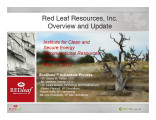 |
Red Leaf Resources, Inc. overview and update | 2012-05-15 | EcoShale; Red Leaf; oil shale; oil extraction | Founded in 2006, Red Leaf Resources, Inc. is a privately-held Delaware corporation based in Salt Lake City, Utah focused on: the production of high-quality oil extracted from oil shale resources, the expansion of its resource portfolio, the licensing of its oil shale extraction technology, the EcoSh... |
| 1979 |
 |
Red Wash 1 (U045) - Plate 8 | 2014 | plate 8; Red Wash 1; well log; core log; Green River Formation | |
| 1980 |
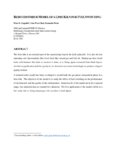 |
Reduced order model of a lime kiln for fuel switching | The lime kiln is an essential part of the causticizing loop in the kraft pulp mill. It is also the last operating unit that routinely fires fossil fuels like natural gas and fuel oil. Displacing these fossil fuels with biomass like bark or sawdust is done, as is firing lignin extracted from black li... | ||
| 1981 |
 |
Reduction of nitric oxide on the char surface at pulverized combustion conditions | 2002 | reduction of nitric oxide; nitric oxide; pulverized combustion; char formation; char surface | This study presents an experimental evaluation of the rate of nitric oxide reduction on the char surface. It addresses the claim that the rate for the destruction of nitric oxide on the char surface has been underpredicted due to char deactivation in the process of char formation. Experiments conduc... |
| 1982 |
 |
Redwash 1 XRF depth plots | 2014 | depth plots; Green River Formation; XRF | |
| 1983 |
 |
Regulatory promotion of emergent CCS technology - Topical report | 2014-01 | CCS technology; climate change; mitigation strategies; carbon capture and sequestration | Despite the growing inevitability of climate change and the attendant need for mitigation strategies, carbon capture and sequestration (CCS) has yet to gain much traction in the United States. Recent regulatory proposals by the U.S. Environmental Protection Agency (EPA), limited in scope to new-buil... |
| 1984 |
 |
Relationships between composition and pulmonary toxicity of prototype particles from coal combustion and pyrolysis | 2009 | toxicity; prototype particles; coal combustion; pyrolysis; health effects; coal combustion fly-ash particles | The hypothesis that health effects associated with coal combustion fly-ash particles are exacerbated by the simultaneous presence of iron and soot was tested through two sets of experiments. The first set created prototype particles from complete and partial combustion, or oxygen free pyrolysis of a... |
| 1985 |
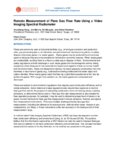 |
Remote measurement of Flare gas flow rate using a video imaging spectral radiometer | 2019 | Flares are commonly used at industrial facilities (e.g., oil and gas extraction and production sites, gas processing plants, oil refineries, and petrochemical manufacturing plants) to safely dispose of process gases (i.e. waste gases). Waste gases may be produced due to process upset or because they... | |
| 1986 |
 |
Reopening Utah's Colleges and Universities | 2020-05 | COVID-19; USHE; higher ed | Executive summary |
| 1987 |
 |
Report of investigation: Oil-impregnated rocks and other evidences of petroleum | 1974-09 | petroleum; oil-impregnated sandstone; oil seep | General geology: The surface geology is entirely Uinta Formation. Most rocks are thinly laminated, fine-grained lacustrine shales and cherts. Only a few sandstone units are present, which are predominantly fine-grained, well-cemented, and lacking in porosity and permeability. Regional dip is gently ... |
| 1988 |
 |
Report of oil-impregnated sandstone in the Hoskinnini of the White Canyon area, Utah | 1974 | oil-impregnated sandstone; Hoskinnini | |
| 1989 |
 |
Report on engineered measures to reduce the salinity differential between the north and south arms of the Great Salt Lake | 1999-12 | salinity reduction; PSOMAS; DFFSL | Procurement and Contract This report fulfills the requirements of the contract between the Utah Department of Natural Resources, Division of Forestry, Fire and State Lands (DFFSL), and PSOMAS. Procurement for this contract was handled under requisition number 560-01000000001, FY2000, and the effecti... |
| 1990 |
 |
Report on geological potential of the areas adjacent to the proposed Ouray-Interstate 70 highway | 1992-02-14 | geological potential; conventional and alternative energy resources; oil shale; tar sands | The area affected by the development of the highway (hereafter referred to as the study area) consists of approximately 1,824,000 acres of land that contain known and potential mineral and energy resources. The study area is located in the eastcentral and southeastern Uinta Basin, and the lowlands s... |
| 1991 |
 |
Report on preliminary results of aerosol measurments at the Rio Blanco oil shale retort, burn #1 | 1982-02 | aerosol measurements; Rio Blanco oil shale retort; oil shale retort; Rio Blanco Retort; characterize potential air emissions | Both the treated and untreated off-gas streams were totally saturated with water vapor at the two sampling locations. The untreated off-gas contained large amounts of liquid water droplets. These contained from 0.04 to 0.09% (by weight] oil. Approximately half of the stack emitted particulate materi... |
| 1992 |
 |
Report on the composition, texture diagenesis, and provenance of the Sunnyside tar sands, Carbon County, Utah | 1984-12-04 | Sunnyside Tar Sands; sandstone composition; tar sand | The sandstones of the Sunnyside tar sand deposit are composed of detrital minerals and rock fragments (70% of rock), carbonate grains (3%). authigenic cements (St), pores plus tar plus solid bitumen (21%), and unidentified constituents (1%) . The detrital minerals and rock fragments are from most to... |
| 1993 |
 |
Report on the development and implementation of the Utah process land use and tax base model | 1974-09 | The preparation of this report was financially aided through a Federal Grant from the Department of Housing and Urban Development, under the Comprehensive Planning Assistance Pregram authorized by Section 701 of the Housing Act of 1954, as amended. | |
| 1994 |
 |
Report on the development of the Utah process: a procedure for planning coordination through forecasting and evaluating alternative state futures | 1972-09 | ||
| 1995 |
 |
Report on the development of the Utah process: a procedure for planning coordination through forecasting and evaluating alternative state futures | 1972-09 | The Utah process development project was funded jointly by the four Corners Regional commission and the Office of Regional Economic Coordination, Department of Commerce. The request for proposal, delivered verbally by George Pantos, special Assistant to the Secretary for Regional economic coordinati... | |
| 1996 |
 |
Report on the Utah rock Asphalt property, Sunnyside bituminous sandstone deposit, Carbon County, Utah | 1960-01-30 | Utah rock Asphalt property; Sunnyside deposit; bituminous sandstone; separation and utilization of biumen from sandstone | The bituminous sandstone deposits near Sunnysida, Utah, are the largest known deposits of this material in the United States. They offer the basis for a large scale operation designed to produce petroleum products and petro chemicals. The deposits are situated near the top of the Book Cliffs, a sout... |
| 1997 |
 |
Report on Utah's second year of planning for the four corners regional commission | 1970-09 | scope of work contained in Article I set forth five specific program elements on which services were to be rendered. These were: 1. Continue to develop and refine criteria and evaluation procedures for assigning priorities to projects submitted for funding by the Four Corners Regional Commission.... | |
| 1998 |
 |
Research Agencies | Research agencies; Higher education; University of Utah | Research agencies for the University of Utah. | |
| 1999 |
 |
Research and information needs for management of tar sands development | 1983 | tar sands management; research needed; tar sands | The purpose of this report is to review the research needed to support the regulatory and managerial role of the agencies in the development of tar sands resources. The material reviewed in preparation for this report was assembled and presented at the Workshop on Research Needs for the Management o... |
| 2000 |
 |
Research investigations in oil shale, tar sand, coal research, advanced exploratory process technology, and advanced fuels research: Volume 1--base program | 1994-05 | oil shale; tar sand; coal research; dvanced exploratory process technology; advanced fuels research; COMPCOAL | This report summarizes the major research investigations conducted by the Western Research Institute under Cooperative Agreement DE-FC21-86MC11076 with the U.S. Department of Energy (DOE) over the period October 1986 through September 1993. In 1989 a Jointly Sponsored Research Program (JSRP) was inc... |
